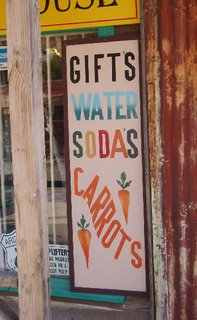Burros, decorated bushes, and tacky souvenir shops

Wednesday, November 30, 2005
I eagerly set out for the nearly abandoned mining town of Oatman on the old-old highway 66. With less than a mile to go, I started seeing bushes decorated for the Christmas season. Made a mental note to ask about the bushes when I got to town.

Before I even found a place to park, I was greeted by the (in)famous burros of Oatman. They are feral, semi-domesticated animals that parade the main street, block vehicle traffic, stand on the board walk, and make pests of themselves begging for handouts. Their usual diet, sold in local shops, is carrots. (see photos)

“Every four to six years, burros double their population. One Arizona ranger commented that ‘at that rate, we’ll soon be up to our ears in asses.’”
Between the locals, the Internet and a book I bought, I learned a lot about Oatman. It began about 90 years ago as a mining tent camp and quickly became a flourishing gold-mining center. In 1915, two miners struck a $10 million gold find, and within a year, the town's population grew to more than 3,500. Highest population was about 7,000.
By 1943, most of the mines had closed and the population dwindled. The town’s only purpose was to serve travelers on the old, old route 66. In 1951 a new section of highway 66 was opened that bypassed Oatman. It almost died.
Today there are about 150 residents in this “authentic old western town.” Intriguing false-front buildings sell tacky souvenirs to tourists.
On my way back to Jeremiah, I met one town resident – Mary (I estimate her to be in her late 80s). “How did you like our town?” she asked. As we talked, she told me about herself: born and raised in San Francisco, plays piano and organ, retired to Oatman about 40 years ago, lives by herself and has numerous dogs that get dumped near her home. She moaned the fact that the town looked like Tijuana, Mexico. And I have to agree. Those lovely old buildings and their covered boardwalks are cluttered with tacky stuff hanging outside: t-shirts, suspenders, blankets, etc.
I asked Mary about the decorated bushes. It is an annual contest for residents. Bushes along the highway are decorated for the holidays. It costs $15 to enter the contest, and if your bush is cleaned up by Feb. 1, you get $10 back. Prizes including trophies and money are awarded.

In 1914 a freightliner – trucks pulled by 16 horses – ran between Oatman and Kingman (the forerunner of highway 66). It took two days to travel one way between the two towns. Today this 26-mile road is VERY narrow and mountainous. (photo)
Once I made it down the mountain from Oatman and through Kingman, I continued east on highway 66 that parallels the railway. The map-dot towns along the way included Valle Vista, Hackberry, Valentine, Peach Springs (on the Hualapai Indian Reservation), Truxton, and Seligman (the birthplace of highway 66).
Hackberry General Store along the highway got my attention as I passed – so I found a place to turn around and go back.
“Big mistake. Many make. Rely on horn. Instead of brake.” Said the Burma-Shave signs that were in the side yard of the General Store. Alongside were very old rusted cars, two burros, several outbuildings, Bonnie’s Food Stand, and a 1942 Ford Thunderbird convertible is cherry condition! Welcome to the past.
Bonnie was sitting in a comfortable chair waiting for customers. Weekdays are slow, she explained. After placing my lunch order with Bonnie, I went inside the general store to find every sort of old highway 66 and Elvis memorabilia. I bought the book, “Stories from The Arizona Coast” (referring to Arizona’s Colorado River coastline communities) written by Paul Taylor. I spent a little more than an hour there, learning about the area. Bonnie (72 years old) retired in Hackberry from Santa Barbara. Her other customer while I was there was Fermin Esquival, a Mohave County building inspector. He said the when he goes through Oatman, he just sort of closes his eyes!
When I drove through Peach Springs, I realized that I was only 20 miles south of the Grand Canyon. I saw several herds of antelope along the road. One of Seligman’s café is named “Roadkill Café.” Seligman looks like an interesting town – and it has an RV Park, so I’ll put this town on my “to be explored on another trip” list.

The last 20 miles today were on Interstate 40. I really loved today’s trip! When I parked at the Grand Canyon RV Park in Ash Fork, I noted that on this trip I’ve driven 2,600 miles so far.

<< Home